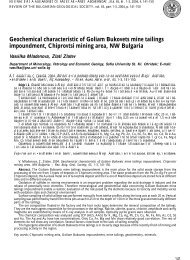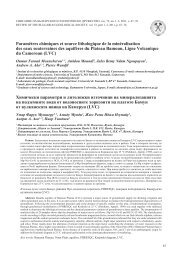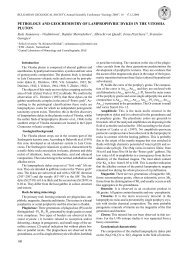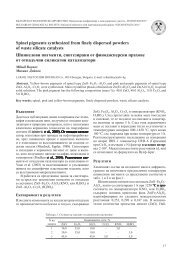30_Metodiev_GeoSci_2.. - Българско геологическо дружество
30_Metodiev_GeoSci_2.. - Българско геологическо дружество
30_Metodiev_GeoSci_2.. - Българско геологическо дружество
Create successful ePaper yourself
Turn your PDF publications into a flip-book with our unique Google optimized e-Paper software.
БЪЛГАРСКО ГЕОЛОГИЧЕСКО ДРУЖЕСТВО, Национална конференция с международно участие „ГЕОНАУКИ 2013“<br />
BULGARIAN GEOLOGICAL SOCIETY, National Conference with international participation “GEOSCIENCES 2013”<br />
New data on the age of the Polaten Formation in Central Balkan Mountains<br />
Нови данни за възрастта на Полатенската свита в Средна Стара<br />
планина<br />
Lubomir <strong>Metodiev</strong> 1 , Elena Koleva-Rekalova 1 , Docho Dochev 2 , Vasil Sirakov 2<br />
Любомир Методиев 1 , Елена Колева-Рекалова 1 , Дочо Дочев 2 , Васил Сираков 2<br />
1<br />
Geological Institute, Bulgarian Academy of Sciences, 1113 Sofia; E-mail: lubo@geology.bas.bg; e_koleva@geology.bas.bg<br />
2<br />
Sofia University “St. Kliment Ohridski”, 1504 Sofia; E-mail: dochev@gea.uni-sofia.bg; vasil_stoqnov@mail.bg<br />
Key words: ammonites, Bathonian, Polaten Formation, Central Balkan, Bulgaria.<br />
Introduction<br />
The review of the regional stratigraphy of the Middle<br />
Jurassic rocks in West and Central Bulgaria by<br />
Sapunov and Tchoumatchenco (1989) provided a<br />
scheme whereby the total chronostratigraphic extent<br />
of the Polaten Formation in the exposures between<br />
the town of Etropole (Yamna Ridge) and the Cherni<br />
Osam River valley (Troyan Mt) (Central Balkan Mts)<br />
ranges from the upper part of the Lower Bajocian to<br />
unspecified part of the Upper Bathonian. Based on<br />
scattered ammonite findings and the distinctive development<br />
of the upper limit of the Polaten Formation in<br />
this area, these authors motivated a rapid eastwards<br />
reduction of its age from the top due to a submarine<br />
washout. Thus the age of the Polaten Formation to the<br />
east of the Cherna Reka River valley (Teteven Region)<br />
was assumed to be merely Bajocian. This view was<br />
later adopted in drawing up of the geological map in<br />
scale 1: 100 000 (i.e. Cheshitev et al., 1994; Sapunov,<br />
Tchoumatchenco in: Cheshitev et al., 1995). During<br />
the last mapping in the area outlined above, we confirmed<br />
the opinion of Sapunov and Tchoumatchenco<br />
(1989), at least with regard to the upper boundary of<br />
the Polaten Formation to the west of the Cherna Reka<br />
River. This was achieved by the discovery of an Upper<br />
Bathonian ammonite field associated with the very top<br />
of the formation near the Chertigrad Summit (Yamna<br />
Ridge) (Fig. 1a, b). Eastwards, in the Troyan Mountain,<br />
we found, however, another new locality with the<br />
same stratigraphic position and almost the same age<br />
(Fig. 1c, d). The ammonites from this locality, called<br />
Chaushov Dol, clearly revealed wider extent of the<br />
Polaten Formation in this area than assumed earlier.<br />
The aim of this study is to give the newly obtained evidence,<br />
as it alters the older stratigraphic point of view,<br />
and moreover that it includes ammonite species unknown<br />
from the Upper Bathonian in Bulgaria so far.<br />
Results and discussion<br />
The studied ammonite localities refer to the last few centimetres<br />
to a few decimetres of the Polaten Formation,<br />
which are overlaid by thinly developed pelagic micritic<br />
limestones of the Yavorets Formation (Fig. 1b, d).<br />
These deposits correspond to locally preserved and disrupted<br />
beds of dark grey, sandy-bioclastic (crinoidal)<br />
limestones, comprising commonly well-rounded quartz<br />
pebbles and angular phosphate grains, common belemnite<br />
rostra, and scattered brachiopods and ammonites.<br />
Another noteworthy feature of these sediments are the<br />
varied allochems (mostly crinoids, but also fragmentary<br />
bivalves, bryozoans, echinoderms and foraminifers,<br />
micritic peloids and intraclasts, as well as fine-grained<br />
and subrounded quartz, feldspars and lithoclasts of<br />
less value). The ammonites from both fields occur as<br />
sufficiently well-preserved internal moulds of whollyseptates<br />
of various sizes and morphologies, as well as<br />
clustered, crushed and phosphatized smaller shells. No<br />
signs of bioerosion and encrustation were observed. The<br />
contents of the ammonite associations imply significant<br />
taphonomic condensation due to prolonged fossil concentration.<br />
But since there is no textural or compositional<br />
difference between the ammonite moulds and the<br />
surrounding sediments, the ammonites can be defined<br />
as coeval with the host rocks. Therefore, they are reliable<br />
source for the dating of the topmost parts of the<br />
Polaten Formation.<br />
The locality near the Chertigrad Summit yielded<br />
common small planulates of the subgenus Homoeoplanulites<br />
(Homoeoplanulites) from which we<br />
recognized H. (H.) aff. ybbsensis (Jussen) and H.<br />
(H.) gr. acuticostatus (Roemer), and a few oxycones<br />
referred to Prohecticoceras aff. blanazense (Elmi).<br />
The Chaushov Dol locality delivered more varied<br />
fauna, including a distinct Procerites pavement by<br />
Procerites (P.) mirabilis (Arkell), attaining big sizes,<br />
73
Fig. 1. Upper Bathonian ammonite-bearing beds from Central Balkan Mts (Bulgaria)<br />
a, location map of locality Chertigrad; b, simplified column of the same locality; c, location map of locality Chaushov Dol (courtesy of A.<br />
Radulov); d, simplified column of the same locality; e, summarized correlation scheme of the studied Upper Bathonian ammonite localities.<br />
Identified species are arranged according to the original positions of the specimens into the beds.<br />
common medium-sized Procerites (Siemiradzkia)<br />
berthae (Lissajous) and Procerites (Siemiradzkia)<br />
spp., large oxycones of Oxycerites oppeli Elmi and<br />
O. subinflexus (de Grossouvre), several complete<br />
adults of Choffatia (Subgrossouvria) richei Mangold,<br />
small planulates of Homoeoplanulites (H.) couxi<br />
(Dominjon) and H. (H.) mangoldi (Dominjon), and a<br />
single Calliphylloceras disputabile (Zittel). As seen<br />
from the listed identified species, both associations<br />
contain valuable Upper Bathonian species, which allowed<br />
the locality near the Chertigrad Summit to be<br />
considered as an indication of the Prohecticoceras retrocostatum<br />
Zone, whereas the Chaushov Dol locality<br />
definitely refers to the Oxycerites oppeli Zone. Hence<br />
the conclusion that despite being generally coeval, the<br />
two fields analyzed differ in age, as the former precedes<br />
in time the latter. On the other hand, the lack<br />
of ammonite record older than P. retrocostatum and<br />
younger than O. oppeli Zones suggests the absence of<br />
the base and the top of the Upper Bathonian (Fig. 1e).<br />
Since we do not have ammonites from levels lower<br />
than the ammonite-bearing beds of the fields studied,<br />
we are not able to evaluate whether the gap of the lowermost<br />
Upper Bathonian is bracketed in this level or<br />
extends from below. From above, it is clear that there<br />
is no record from the topmost Bathonian approximately<br />
up to the base of the Upper Callovian (Sapunov,<br />
Tchoumatchenco in: Cheshitev et al., 1995). This major<br />
discontinuity is well-documented in the literature,<br />
and an overall shallowing up trend on a regional scale<br />
was adopted (Sapunov, Tchoumatchenco, 1989), but<br />
we believe that it is rather a contrary eustatic signal. The<br />
above considered cases of condensation revealed an appearance<br />
through mechanical concentration, limited by<br />
periods of low or no sedimentary influx. The condensations<br />
were produced by combined winnowing/sieving<br />
processes, during an episode of sea-level rise, as stated<br />
by Fels and Seyfried (1993) on similar examples from<br />
the Jurassic in Subbetic Plateau (SE Spain).<br />
References<br />
Cheshitev, G., T. Nikolov, V. Milanova, Tz. Chontova. 1994.<br />
Explanatory Note to the Geological Map of Bulgaria on<br />
Scale 1:100 000. Trojan map sheet. Sofia, Committee of<br />
Geology, Geol. and Geoph. Corp., 105 p. (in Bulgarian).<br />
Cheshitev, G., V. Milanova, I. Sapunov, P. Tchoumatchenco.<br />
1995. Explanatory Note to the Geological Map of Bulgaria<br />
on Scale 1:100 000. Teteven map sheet. Sofia, Committee<br />
of Geology, Geol. and Geoph. Corp., 94 p. (in Bulgarian).<br />
Fels, A., H. Seyfried. 1993. “A la recherche du temps perdu”:<br />
On geological condensation, with examples from the<br />
Jurassic Subbetic Plateau in Southeastern Spain. – N. Jb.<br />
Geol. Paläont. Abh., 189, 1–3, 13–31.<br />
Sapunov, I., P. Tchoumatchenco. 1989. Some new concepts on<br />
the lithostratigraphy of the Middle Jurassic marine sediments<br />
in West and Central Bulgaria. – Rev. Bulg. Geol.<br />
Soc., 50, 1, 15–25 (in Bulgarian).<br />
74









